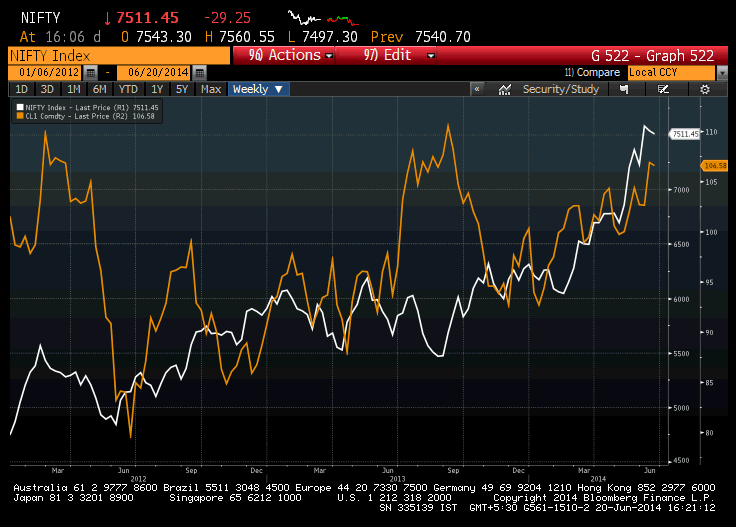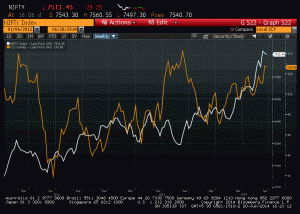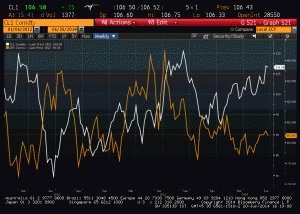MYTH : MONSOON AND NIFTY RETURNS
The last two weeks have seen the market in a sideways move. As usual, the doubting Thomases have started the usual round robin circulation of WhatsApp messages. The media are working overtime on how the effect of El Nino can derail the ongoing stock market rally. The prospect of El Nino does sound depressing. It does prima-facie lead one to conclude that the economic effects will be disastrous and as a corollary the market will crash. This whole concept of El Nino and droughts is pretty confusing since there are myriad possibilities for eg. (a) El Nino and drought, (b) Mild El Nino and drought (c) El Nino and no drought and of course (d) No El Nino but drought. It seems in 1997/98 there was a strong El Nino occurrence but there was no drought, though it is said that a strong El Nino can cause drought like conditions. Also, it seems that 2002 was a moderate El Nino year but the drought was severe. According to information, about 90 % of all El Nino years record deficient monsoon and 65 % of El Nino years result in droughts. So, one can safely say that El Nino does have an effect on Monsoon in India.
It has been correctly said that predicting the weather is exactly like predicting the market (both are irrational). I fully agree that El Nino will affect agricultural productivity and sectors which are dependent on agriculture. The myth is that we are still an agrarian economy. Assuming that we have a below normal monsoon what does history tell us of previous such occurrences? Since I know very little about the weather and just a little bit more about the market, I collated the following data and was positively surprised with the results:
| YEAR | OCCURRENCE | IMPACT | NIFTY ON 01 ST JAN | NIFTY ON 31 ST DEC | NIFTY RETURNS (%) |
| 2002 | EL NINO | DROUGHT | 1055.3 | 1091.85 | 3.40 |
| 2004 | EL NINO | DROUGHT | 1912.25 | 2080.5 | 8.79 |
| 2009 | EL NINO | SEVERE DROUGHT | 3033.45 | 5201.05 | 71.45 |
IS INDIA AN AGRARIAN ECONOMY?
How does one explain the historical market behaviour in drought years? The fact of the matter is that India is less agrarian than is widely believed. The reason for such large FII inflows is that the image of India as a rural economy is no longer valid. The transition from agriculture to industry has been very rapid in rural India over the past two decades. The conclusion the FII’s, who are the dominant investors have arrived at is that the Indian economy is no longer an agrarian economy and hence is not exposed to the vicissitudes of an erratic monsoon. The domestic investors must accept that India is more urban than rural. Consider the following:
-
In the calendar year 2009 we had a severe drought and it also happened to be an election year, but the Nifty gave stellar returns.
-
In the calendar year 2013 we had a very good monsoon, but it did not translate into significant returns on the Nifty.
-
Today agriculture is only 1/4 th of GDP which is down from being 1/2 of GDP. In fact, most of the manufacturing happens in rural India (due to tax sops etc) and these today create a majority of the jobs.
-
All agriculture is rural but the converse is not true. In rural India, jobs are switching away from agriculture. The trend of more and more villages merging into towns is ubiquitous throughout the hinterland. Statistics show that the per capita GDP in rural areas is growing much faster than in urban areas due to ‘rural urbanisation’.
-
This rural urbanization has been one of the key reasons for such a landslide victory for the BJP since they were clearly tech savvy when no one else was. WhatsApp messenger is omnipresent in the remotest parts of India. Farmers are now more tech savvy than they were earlier, there are a number of farming apps available to them on their smart phones, technology helps them to become smart farmers. Farming with apps is now a reality.
-
India’s ‘agri story’ is more than just the monsoons, there are many other man-made facets like prices and politics.
-
In most Indian villages, which were supposed to be predominantly rural and agricultural, life has been turned upside down by technology in the form of internet, cable television etc. The majority of Indian villages are living a “city life”, this is visible to the naked eye and requires no research.
-
The most interesting developments are happening outside the cities. Had anyone heard of Sanand before the Tata Nano moved in? Do you till believe that they are agrarian in Sanand?
-
Most investors choose to believe that we are on the verge of a drought. There is a difference between ‘Excess’, ‘Normal’, ‘Deficient and ‘Scanty’ rainfall as can be seen below
Excess : 20% of Normal or more
Normal : +19% to -19% of Normal
Deficient : -20% to -59% of Normal
Scanty : -60% of Normal or less
(When the rainfall is within 10 % of its long period average it is considered Normal).
-
In most villages more than half of the people derive their income from activity other than farming. The jury is out on whether this is a desirable trend or otherwise (in any case it does not form the subject matter of this blog). If investors are basing their investment decisions on the basis of an erratic monsoon then they are choosing to believe in a myth.
MYTH : CRUDE PRICES AND NIFTY RETURNS
There is an ongoing debate about the price of crude oil and how a spike will affect the economy. Have we not got used to this myth? The prices of crude oil have shot up due to the ongoing crises in Iraq. It has become routine for some despot in the Middle East to get excited, this has happened so often in the past. The current ‘Iraq crisis’ is actually a regional conflict and regional conflicts seldom have lasting effects on stock prices. The spike in oil prices can best be described as sentiment driven. It has been proved time and again that these are temporary spikes. The market gets a whiff of the impending solution much before the rest of us and tends to move so fast that it is impossible to enter. If investors wait till the media delivers an all clear signal then they will be left waiting. The graph below shows the historical data of Nifty v/s Crude oil prices from January 06, 2012 till June 20,2014.
(click on the image to enlarge)
The above clearly shows that the index and crude prices are positively correlated and not inversely correlated. In other words crude prices and the market move in tandem with each other and not in an inverse manner as is the popular belief. There is an inverse relation between the U.S. dollar and crude prices i.e. the dollar tends to weaken as crude oil prices rise. This can be seen below
(click on the image to enlarge)
CONCLUSION
The dips associated with these myths can at best be construed as buying opportunities. The monsoon fears and the crude crisis are just two bricks in the proverbial wall of worry which this bull market is set to climb. It has been historically proved that what is perceived as tomorrows greatest threat almost never is. The biggest risk in the Indian markets today is something which no one talks about : excessive pessimism. Investors will be well advised to ‘buy the dip’ .


